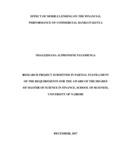| dc.contributor.author | Ndagijimana, Alphonsine N. | |
| dc.date.accessioned | 2018-01-05T12:39:22Z | |
| dc.date.available | 2018-01-05T12:39:22Z | |
| dc.date.issued | 2017 | |
| dc.identifier.uri | http://hdl.handle.net/11295/102241 | |
| dc.description | Research project submitted in partial fulfillment of the requirements for the award of the degree of master of science in finance, school of business, university of Nairobi | en_US |
| dc.description.abstract | Mobile lending is a service provided by financial institutions in cooperation with mobile phone operators. It allows customers with busy lives to conveniently do their banking using their phones anytime. It is about getting banking services to the unbanked, those who do not have bank access or bank accounts, and those who are at the bottom of the economic pyramid often living in remote areas. The study sought to determine the effect of mobile lending on financial performance of commercial banks in Kenya. Cross sectional descriptive survey was employed in this case. This informed who how and what about the mobile banking in commercial banks in Kenya and as a one –time event. The study adopted a census method where all the commercial banks practicing mobile lending in Kenya were studied. The study made use of secondary data from the Audited Financial Statements of the banks, those deposited at the Nairobi Securities Exchange and financial performance data from CBK annual banking survey reports. The data collected was cleaned, coded and systematically organized in a manner that facilities analysis using the Statistical Package for Social Sciences (SPSS). Data was analyzed on the basis of the mean and the F test statistic was computed at 5% significance level. To test for the strength of the model and the effect of mobile lending on the financial performance of commercial banks in Kenya, the study conducted an Analysis of Variance (ANOVA). From the regression model, the study found out that there were mobile lending variables influencing the financial performance of commercial banks in Kenya, which are; interest rates, capital adequacy and liquidity. They influenced it positively. The study found out that the 5 independent variables that were studied which included Total Mobile Loan Applicants, Total amount of mobile loans, interest rates, capital adequacy and liquidity explain 47.4% of financial performance of commercial banks in Kenya as represented by adjusted R2. The study therefore concludes that mobile lending positively and significantly affects the financial performance of commercial banks in Kenya. The study recommends that policy makers consider mobile lending in their formulation of policies because of the technological developments and the expected switch from physical branch networks to technologically supported banking services. The study further recommends that commercial banks keep adopting and using mobile lending in their operations because the number of people with access to a mobile handset is increasing everyday. This study recommends that, a study be conducted to assess the effect of mobile lending on the economic growth. This will be interesting to see whether a relationship exists between financial performance and economic growth. | en_US |
| dc.language.iso | en | en_US |
| dc.publisher | University of Nairobi | en_US |
| dc.rights | Attribution-NonCommercial-NoDerivs 3.0 United States | * |
| dc.rights.uri | http://creativecommons.org/licenses/by-nc-nd/3.0/us/ | * |
| dc.title | Effect of Mobile Lending on the Financial Performance of Commercial Banks in Kenya | en_US |
| dc.type | Thesis | en_US |



